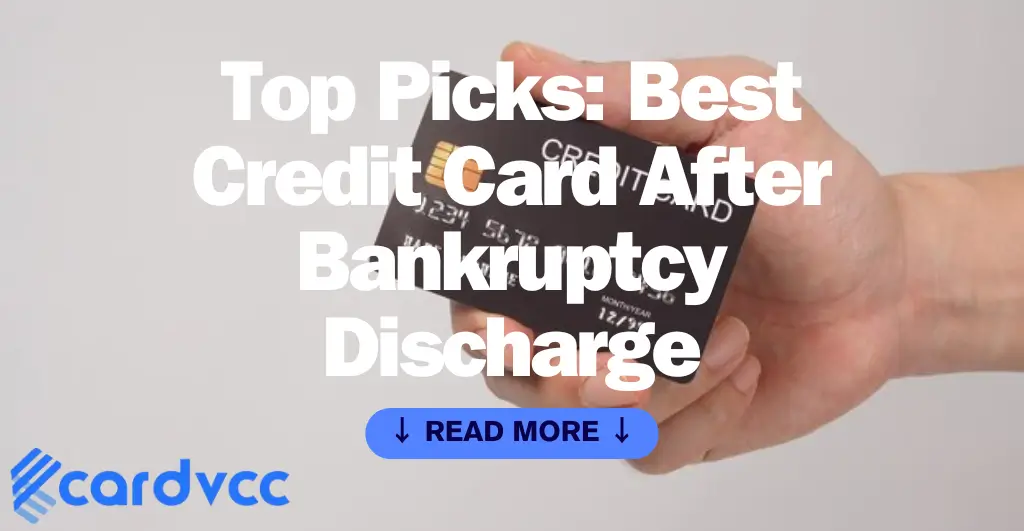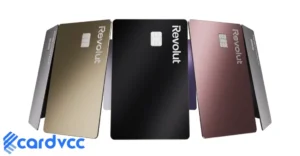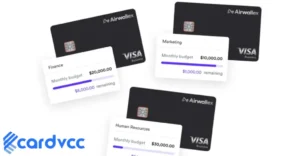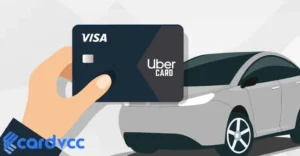The best credit card after bankruptcy discharge is the Discover it Secured Credit Card. It helps rebuild credit responsibly.

Rebuilding credit after bankruptcy is crucial for financial recovery. A secured credit card is an excellent starting point. These cards require a security deposit, which acts as your credit limit. The Discover it Secured Credit Card offers cashback rewards and reports to all three major credit bureaus.
This card helps improve your credit score with responsible use. Always pay your balance in full and on time to avoid interest and fees. Gradually, you may qualify for better credit cards. Rebuilding credit takes time and discipline, but it is entirely possible with the right tools.
Choosing A Credit Card Post-bankruptcy
After a bankruptcy discharge, rebuilding credit is crucial. Choosing the right credit card helps. This section focuses on key factors to consider. It also compares secured and unsecured cards.
Factors To Consider
Several factors matter when choosing a credit card post-bankruptcy:
- Annual Fees: Look for cards with low or no annual fees.
- Interest Rates: Find cards with lower interest rates.
- Credit Limit: Opt for cards offering a fair credit limit.
- Rewards: Some cards offer rewards. Choose one that fits your spending habits.
- Approval Odds: Check if you pre-qualify. This avoids hard inquiries.
Secured Vs. Unsecured Cards
Two main types of credit cards exist: secured and unsecured. Each has its pros and cons.
| Feature | Secured Cards | Unsecured Cards |
|---|---|---|
| Deposit Required | Yes, a security deposit is needed. | No, no deposit is required. |
| Credit Limit | Often equals the deposit amount. | Based on creditworthiness. |
| Approval Odds | Higher for those with bad credit. | Lower for those with bad credit. |
| Building Credit | Helps rebuild credit effectively. | Can help, but harder to get. |
Secured cards require a deposit. This makes them easier to get. They are good for rebuilding credit. Unsecured cards don’t need a deposit. They are harder to get but can offer more perks.
Secured Credit Cards
Rebuilding credit after a bankruptcy discharge can be tough. Secured credit cards offer a smart way to rebuild your credit score. They are designed for people with poor credit or no credit history.
How They Work
Secured credit cards require a cash deposit as collateral. This deposit usually equals your credit limit. For example, a $300 deposit gives you a $300 credit limit. The card works like any other credit card. You make purchases and pay the bill each month. The deposit reduces the risk for the card issuer. If you default, they use the deposit to cover the debt.
Most secured cards report to the major credit bureaus. Paying on time helps build your credit score. Over time, responsible use can lead to an unsecured card offer.
Best Options Available
Several secured credit cards stand out for their features and benefits. Here are some top options:
| Card Name | Minimum Deposit | Annual Fee | Rewards |
|---|---|---|---|
| Discover it® Secured | $200 | $0 | 1-2% cash back |
| Capital One Secured | $49, $99, or $200 | $0 | None |
| OpenSky® Secured Visa® | $200 | $35 | None |
Discover it® Secured offers 1-2% cash back on purchases. It has no annual fee and reports to all three major credit bureaus.
Capital One Secured requires a deposit between $49 and $200. It has no annual fee and can increase your credit limit without additional deposits.
OpenSky® Secured Visa® requires a $200 deposit and has a $35 annual fee. This card does not require a credit check, making it accessible to many.
Choose a secured credit card wisely. Rebuild your credit score and gain financial stability.
Unsecured Credit Cards
Emerging from bankruptcy can be a challenging time. Finding the right credit card is essential to rebuild your financial health. One of the best options is unsecured credit cards. These cards don’t require a security deposit, unlike secured cards. They can help you start fresh and improve your credit score.
Eligibility Criteria
Before applying for an unsecured credit card, it’s important to understand the eligibility criteria. Most issuers have specific requirements:
- Proof of income
- Stable employment history
- Current address verification
- Bankruptcy discharge documents
- Credit score above a specific threshold
Meeting these criteria increases your chances of approval.
Top Picks For Rebuilding Credit
Here are some of the best-unsecured credit cards for those who have faced bankruptcy:
- Capital One Platinum Credit Card
- No annual fee
- Access to higher credit line after making on-time payments
- Credit One Bank Unsecured Visa
- Automatic reviews for credit line increases
- 1% cash back on eligible purchases
- Indigo Platinum Mastercard
- Pre-qualification without impacting your credit score
- Reports to all three major credit bureaus
These cards offer great features for rebuilding credit. They don’t require a security deposit. They also provide opportunities for credit line increases.
Credit Card Features To Look For
Choosing the right credit card after bankruptcy discharge can be challenging. Focus on key features to help rebuild your credit. Not all credit cards are the same. Some offer better terms and benefits suited for your situation.
Low Fees And Interest Rates
Look for credit cards with low fees and interest rates. High fees can quickly add up and make it harder to manage your finances. Some cards charge annual fees, while others do not. Aim for cards with no annual fees or low ones.
Interest rates impact how much you’ll pay on any balance you carry. A lower interest rate means less money is spent on interest. Compare different cards to find the best interest rates available.
Here’s a quick comparison table:
| Credit Card | Annual Fee | Interest Rate |
|---|---|---|
| Card A | $0 | 15% |
| Card B | $25 | 18% |
| Card C | $50 | 20% |
Credit Reporting
Choose a credit card that reports to all three major credit bureaus. This helps rebuild your credit score faster. Consistent reporting shows your ability to manage credit responsibly.
Some credit cards only report to one or two bureaus. Ensure your card reports to Equifax, Experian, and TransUnion. This way, your positive payment history is recorded everywhere.
Cards that report to all three bureaus usually mention it in their terms. Read the fine print before applying to confirm.
- Equifax
- Experian
- TransUnion

Rebuilding Credit Scores
After a bankruptcy discharge, rebuilding credit scores is crucial. It can feel daunting, but with the right steps, you can improve your credit score. This guide will help you understand the key strategies for rebuilding your credit.
Importance Of On-time Payments
On-time payments are essential for rebuilding credit. Each payment you make on time helps improve your credit score. Set reminders or automate payments to avoid missing due dates.
Even one late payment can negatively impact your credit score. Consistency is key. Make sure you pay all your bills on time, every month.
Keeping Utilization Low
Another critical factor is keeping your credit utilization ratio low. This ratio is the amount of credit you use compared to your credit limit. Aim to use less than 30% of your available credit.
For instance, if your credit limit is $1,000, try to keep your balance below $300. This shows lenders you are responsible with credit.
Here’s a quick table to help you understand:
| Credit Limit | Recommended Balance |
|---|---|
| $500 | <$150 |
| $1000 | <$300 |
| $2000 | <$600 |
Remember, keeping your utilization low is a powerful tool for rebuilding credit.
Using Credit Responsibly
After a bankruptcy discharge, it is crucial to use credit responsibly. Proper management helps rebuild your financial health. Follow these guidelines to ensure you use credit wisely and avoid falling into debt again.
Setting A Budget
Creating a budget is essential for managing your finances. A budget helps track your expenses and income. Use a budgeting app or a simple spreadsheet. List all your sources of income and monthly expenses. Include rent, utilities, groceries, and debt repayments. Allocate a portion of your income to savings.
Sticking to a budget prevents overspending. It ensures you have enough money to pay off your credit card balance each month. Avoid carrying a balance to prevent interest charges. Paying your full balance on time boosts your credit score.
Avoiding New Debt
After a bankruptcy discharge, it is important to avoid new debt. Resist the temptation to open multiple credit accounts. Too many accounts can lead to overspending. Only apply for credit when necessary. Choose a secured credit card or a card for those rebuilding credit.
- Limit credit card usage to essential purchases.
- Pay your balance in full each month.
- Monitor your credit report regularly.
Using credit responsibly after bankruptcy discharge ensures financial stability. It helps rebuild your credit score and secures your financial future.
Monitoring Your Credit Progress
After a bankruptcy discharge, it’s crucial to monitor your credit progress. Keeping track of your credit score helps rebuild your financial standing. This section covers how to do that effectively.
Utilizing Free Credit Reports
Accessing your credit reports is the first step. You can get a free report from each of the three major credit bureaus annually. These bureaus are:
- Equifax
- Experian
- TransUnion
Visit the Annual Credit Report to request your reports. Check each report for errors. Correct any mistakes immediately. This helps improve your credit score.
Tracking Improvements
Track your credit score improvements over time. Use free tools like:
- Credit Karma
- Credit Sesame
- Banking apps with credit score features
These tools provide regular updates on your credit score. They help you see how your actions impact your score. Set monthly goals for credit improvement.
| Credit Task | Impact on Score |
|---|---|
| Paying bills on time | Positive |
| Reducing debt | Positive |
| Opening new credit accounts wisely | Neutral to positive |
| Checking credit report for errors | Positive |
Keep an eye on these tasks to see steady improvements. Celebrate small victories along the way.
Long-term Financial Health
After a bankruptcy discharge, focusing on long-term financial health is crucial. Rebuilding your credit and maintaining responsible financial habits can set you on a path to stability. Here are some key steps to consider.
Establishing Financial Goals
Setting clear financial goals is essential for your recovery. Start by defining short-term and long-term objectives. Use the following steps to create a solid plan:
- Identify your financial priorities.
- Create a realistic budget.
- Track your expenses diligently.
- Save an emergency fund.
Having specific goals helps you stay focused and motivated. You can achieve financial stability step by step.
Seeking Professional Advice
Professional guidance can be incredibly beneficial. Consider consulting with a financial advisor or credit counselor. They can provide personalized advice based on your unique situation.
Here are some benefits of seeking professional help:
| Benefit | Description |
|---|---|
| Customized Plans | Get a tailored financial recovery plan. |
| Debt Management | Learn strategies to manage and reduce debt. |
| Credit Rebuilding | Receive tips to rebuild your credit score. |
| Investment Advice | Explore safe investment options for future growth. |
By following these steps, you can improve your financial health and regain control over your finances.

Frequently Asked Questions
What Is The Best Credit Card After Bankruptcy?
The best credit card after bankruptcy is typically a secured credit card. It requires a deposit, which acts as your credit limit.
How Can I Get A Credit Card Post-bankruptcy?
To get a credit card post-bankruptcy, start with secured credit cards. They are easier to get and help rebuild credit.
Are There Credit Cards For Bad Credit?
Yes, there are credit cards specifically designed for bad credit. These include secured credit cards and some unsecured cards.
How Long After Bankruptcy Can I Apply For A Credit Card?
You can apply for a secured credit card immediately after bankruptcy discharge. Unsecured cards may require a longer wait.
Conclusion
Choosing the best credit card after bankruptcy discharge can rebuild your financial future. Evaluate options carefully and prioritize low fees. Responsible usage will help improve your credit score. Remember, the right credit card can be a powerful tool for financial recovery.







